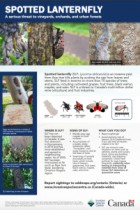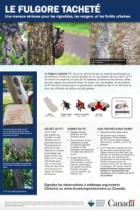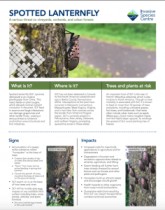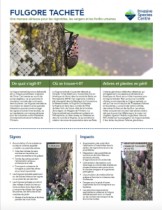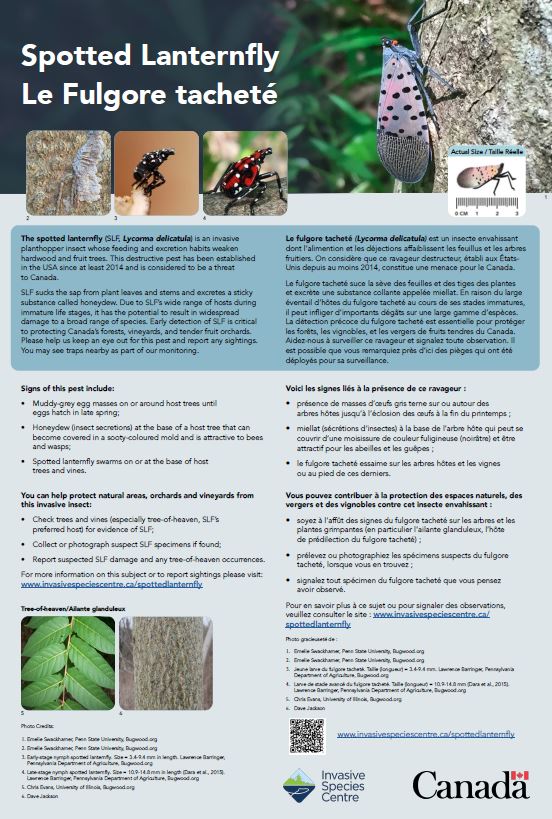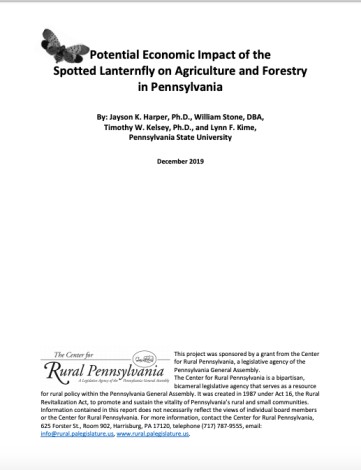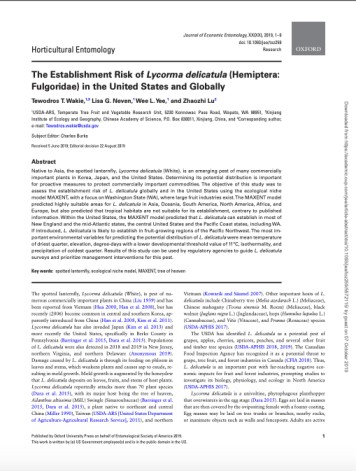Spotted Lanternfly (Lycorma delicatula)
French common name: Le fulgore tacheté
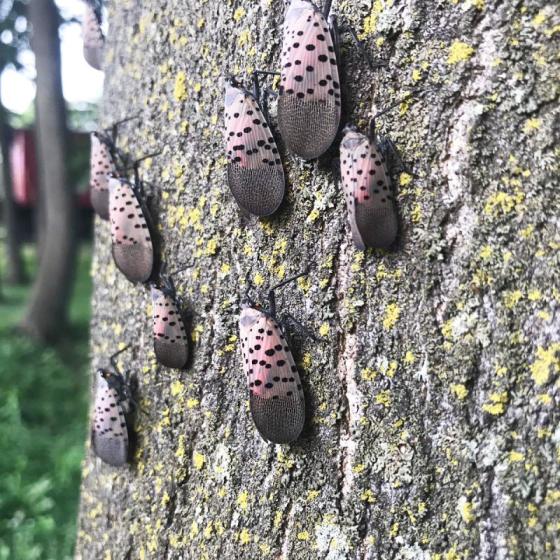
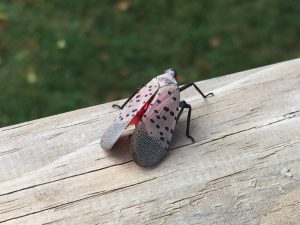
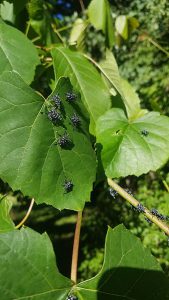
Order: Hemiptera
Family: Fulgoridae
As of September 9, 2022, over 100 spotted lanternfly adults have been found in a residential area of Buffalo, New York, adjacent to an active rail line. The New York State Department of Agriculture and Markets’ Division of Plant Industry inspectors will continue to survey the surrounding areas in the coming days.
Read the full media release here.
Spotted lanternfly (SLF; Lycorma delicatula) is planthopper native to Southeastern Asia that has become an invasive insect pest in the United States. Its first known North American establishment was in Berks County, Pennsylvania, U.S.A. in September 2014, but it is likely this species was first introduced in 2012. SLF has yet to be detected in Canada.
While the invasive tree-of-heaven (Ailanthus altissima) is a preferred plant host, SLF is known to feed on a wide range of native hardwood and fruit trees. Grapevines are particularly vulnerable to SLF, which feed on them in large swarms. Currently, intense management efforts are underway in parts of the U.S. with a focus on public awareness, detection surveys, and eradication. If this species spreads to Canada, it could be a formidable threat to various industries and the economy, in particular the horticulture, tender fruit and grape product industries.
Quick Tips:
- Learn to recognize SLF at all life stages (eggs, nymphs and adults) and report all sightings to the Canadian Food Inspection Agency. Remember to SPOT IT, SNAP IT, CATCH IT and REPORT IT.
- SPOT IT – In the spring and summer, be on the lookout for SLF nymphs and adults. In the fall and winter, look for SLF egg masses.
- SNAP IT – Try to get clear photographs of the specimen(s).
- CATCH IT – Scrape off egg masses into a plastic bag filled with hand sanitizer or rubbing alcohol and seal it. A plastic bag with egg masses can also be stored in the freezer if hand sanitizer or rubbing alcohol are not readily available. If you find an SLF nymph or adult, try to put it into a sealed container for specimen confirmation. SLF does not bite or sting.
- REPORT IT – Submit precise location and habitat information and any photographs of SLF eggs, nymphs or adults to the Canadian Food Inspection Agency at Contact CFIA online – Canadian Food Inspection Agency (canada.ca).
- If you are visiting an infested area, check your vehicle and any items that sat for a period of time outdoors (such as camping equipment) for egg masses, nymphs or adults before returning. You can even run your vehicle through a high-pressure car wash. Check out this travel checklist for more tips.
Eggs: Brown, seed-like, and covered in a grey, muddy-looking secretion to form an egg mass arranged vertically. Can be laid on almost any natural or artificial hard surface occurring outdoors.
Nymphs: Occur in four growth phases (instars). The first three instars are black with white spots, with each successive instar becoming larger. The fourth instar is bright red with black and white spots.
Adults: Forewings are approximately 1” long and are pinkish-grey with black spots and black veins at the tips. When the forewings are open, the bright red underwings become visible (for example in flight).
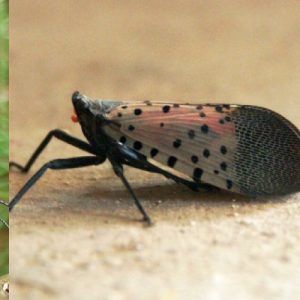
Photo: Lawrence Barringer, Pennsylvania Department of Agriculture, Bugwood.org
Life Cycle
The spotted lanternfly completes its life cycle in one year:
- Eggs hatch into nymphs in spring (April) and mature through four nymphal stages, until they develop into winged adults around mid-summer (July)
- Feeding takes place from April until November, with nymphs having a wide range of plant hosts and adults tending to specialize on preferred hosts like tree-of-heaven, black walnut, and grapevines
- In late summer (September), adults will mate and lay eggs
- Eggs overwinter as masses covered in a muddy-looking secretion; adults do not survive through winter
Spotted lanternfly egg mass:
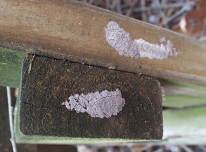

Spotted lanternfly nymphs:
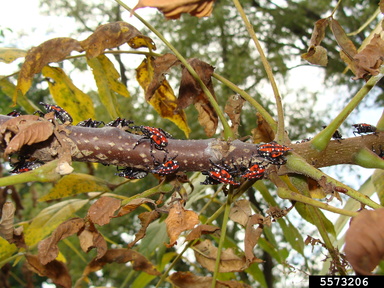




SLF feeds on a wide range of plants and trees. Over 100 potential host species have been recorded, including:
- Tree-of-heaven
- Black walnut
- Willows
- Maples
- Oaks
- Apple
- Pear
- Hops
- Prunus spp. (plumcherry, peach, nectarine, apricot trees)
- Vitis spp. (grapevines)
As an adult, SLF prefers tree-of-heaven, although it has also been observed to feed heavily on black walnut and cultivated grapevines. Tree-of-heaven is itself highly invasive and widespread. To learn how to identify and report it, see here. While substantial feeding has not been observed on conifers, Christmas tree farms may still act as vectors for SLF spread.
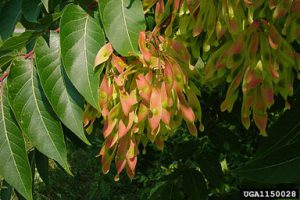

Tree of Heaven. Photo: Chuck Bargeron, University of Georgia, Bugwood.org
Signs of spotted lanternfly presence include:
- Egg masses that appear as a smear of mud on hard surfaces outdoors in the fall and winter; coating can be dry and cracked later in the season, sometimes exposing the eggs themselves
- Dark streaks of sap flowing down the bark of the tree resulting from SLF feeding
- Insect secretions called honeydew at the base of a host tree, often fostering sooty mold
- Increased bee and wasp activity due to exposed sap and honeydew
- Large swarms of adult SLF congregating on host trees in the fall, especially on preferred hosts like tree-of-heaven, black walnut and grapevines
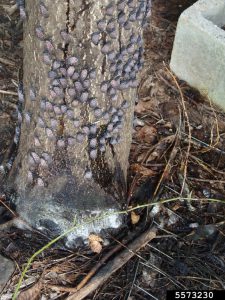

Photo: Emelie Swackhamer, Penn State University, Bugwood.org
Build-up of honeydew secretions at the base of a tree, a sign of a heavy spotted lanternfly infestation.
Spotted lanternfly is native to Southeastern Asia, including parts of China, Taiwan, and Vietnam. It is an invasive pest in Japan, South Korea, and more recently, the U.S.
The first North American detection occurred in 2014 in Berks County, Pennsylvania. As of May 2023, SLF has spread to New Jersey, Delaware, Maryland, Virginia, New York, Connecticut, West Virginia, Rhode Island, Indiana, Massachusetts, North Carolina, Michigan, and Ohio. The nearest infestation to the Canada-U.S. border is in Buffalo, New York, where over 100 adult spotted lanternflies were detected in September 2022.
Confirmed locations of SLF infestations in the United States are updated on an ongoing basis by the New York State Integrated Pest Management Program here: Spotted Lanternfly Map – Stop SLF
You can see spotted lanternfly observations in Canada on the Canadian Food Inspection Agency website.
The feeding behaviour of SLF can weaken plants and even kill certain species, like grapevines and tree-of-heaven. They tend to feed in swarms and excrete a sticky, sugary substance called honeydew. The honeydew fosters sooty mold growth, which can also harm the host plant by reducing photosynthetic capacity. SLF poses a particular threat to the grape and wine industry, but may have impacts on apple, hops, tender fruit, and forestry industries as well. Their presence can also negatively impact outdoor recreation in parks and other urban green spaces. Given that spotted lanternfly has such a wide range of plant hosts and their establishment in the U.S. is relatively recent, research on their overall impacts on vineyards, orchards, street trees, and forests is ongoing.
Economic impacts
In Pennsylvania where this pest was first detected in North America, impacts on the agricultural industry have been significant. A study conducted in 2019 estimates the total economic impact of SLF within the 14 counties that were under quarantine at the time of the study, the adjacent counties, and the entire state of Pennsylvania. According to the study, the overall annual direct economic impact of SLF damage on Pennsylvania agriculture is estimated to be $13.1 million in the quarantine zone, $7.7 million in the adjacent counties, and $42.6 million statewide (Harper et al., 2019). Losses are projected to be heavily incurred by grape growers in particular.
Similar economic concerns exist if this pest were to establish itself in Ontario, with the wine and grape industry at the greatest risk. It is estimated that this industry in the province of Ontario alone is worth $5.9 billion (Wine Growers Ontario, 2019). In addition, Ontario’s $43 million tender fruit industry (including peaches, pears, plums, and nectarines) (Ontario Tender Fruit Producer’s Marketing Board, 2014), and $60 million apple industry (Ontario Apple Growers, 2015) are all threatened by the potential arrival of SLF. Given its potential impacts on forest ecosystems, SLF also poses a risk to a $1 billion logging industry (NRCan, 2012), a $558.5 million maple products industry (Statistics Canada, 2020), and a $90.2 million Christmas tree industry (Statistics Canada, 2021) in Canada.
Estimates and actual expenditures incurred by managing spotted lanternfly could vary widely between provinces in Canada depending on the severity of SLF infestations and the measures put in place to control them.
The spotted lanternfly attacks many important agricultural trees and plants, including the grapevine. If this invasive species were to establish in Ontario, it would threaten the $3.3 Billion wine industry. |
Ecological impacts
While it is primarily considered an agricultural pest, SLF could have widespread ecological impacts due to its broad range of possible plant feeding hosts, including hardwood trees.
Damage to tree-of-heaven, the main host of the adult spotted lanternfly, is of low ecological concern – tree-of-heaven is an invasive tree species originating from China and is frequently the focus of other control and eradication efforts. However, other potentially susceptible host trees include native species, such as black walnut, willows and maples. The extent of impacts on these species is currently unknown, but there could be negative overall impacts on forest and street tree health. Even when SLF does not cause tree mortality, the stress induced from an infestation can weaken a tree’s defenses, making it more vulnerable to attack from other insects or pathogens.
Social impacts
SLF threatens vineyards and fruit orchards, which can result in significant social impacts if the insect becomes established. For example, popular summer activities could be impacted, such as apple picking, enjoying fresh produce from farmer’s markets, or wine tasting at local vineyards.
While SLF does not bite, sting, or otherwise directly harm humans, infestations can still reduce our enjoyment of parks and urban green spaces in several ways:
- Sap weeping wounds and sticky pads, caused by feeding and honeydew excretion, respectively, attract stinging insects and pests like bees, wasps, hornets, and ants
- Honeydew falls on passersby and is sticky and unpleasant
- SLF can compromise the aesthetics of a park’s greenery by swarming tree trunks, causing leaf wilt and branch dieback, and excreting honeydew which fosters the growth of sooty mold
- SLF adults can fly into or land on people, causing park visitors discomfort
Currently in Canada, action on SLF has focused on preventative monitoring efforts, raising public awareness, and educating industry stakeholders. This will increase the likelihood of early detection and rapid response to the spotted lanternfly if it arrives here.
Regulations
Quarantine zones have been established in Pennsylvania to slow the spread of SLF, meaning certain protocols are in place to prohibit the movement of SLF and regulate the movement of commercial trucks and materials potentially containing egg masses, nymphs or adults.
Initially, six townships within Berks County, Pennsylvania quarantined starting in November 2014. As of May 2023, 51 counties in Pennsylvania are under quarantine.
Despite these efforts to contain SLF, it has spread from Pennsylvania to other states. Similar quarantines also exist in Virginia, West Virginia, New York, New Jersey, Maryland and Delaware. Research is ongoing to determine long-term, sustainable ways to manage SLF and prevent its spread.
In Canada, SLF was placed on the federal regulated pest list in 2018, making it regulated under the authority of the Plant Protection Act.
Monitoring
SLF monitoring has been conducted in Ontario by the Ministry of Agriculture, Food and Rural Affairs (OMAFRA). Bug barrier traps have been deployed throughout high-risk sites, particularly in areas that border the U.S. (e.g., Niagara Region and Essex County), support long distance travel with extended parking (e.g., hotels, highway rest stops, wineries, provincial parks, campgrounds, trucking companies, etc.), and have host trees (e.g., tree-of-heaven, black walnut).
Control
Where spotted lanternfly has been detected in the United States, several control options are available. These methods are sometimes used in combination, on a site-by-site basis.
Mechanical Control
Scrape egg masses off infested trees – A flat object (such as a knife or plastic card, or specialized tool for this purpose) is used to scrape egg masses off the tree trunk. Egg masses are killed and disposed of.
Tree banding– adhesive paper bands are placed around high-risk trees to capture SLF as they ascend and congregate on the trunk. Tree bands are routinely removed and disposed of to kill SLF individuals.
Tree removal – Removal of infested trees, and high-risk host trees (such as tree-of-heaven) up to 400 metres from an infested site
Chemical Control
Chemical control of SLF in the U.S. can include reduced toxicity substances, like insecticidal soaps, or insecticides registered under the Environmental Protection Agency. Insecticides are used to kill spotted lanternflies either systemically or on contact. Contact insecticides are directly sprayed at the insect, killing it. Depending on the contact insecticide, some have a long residual activity and can continue killing spotted lanternflies as they walk over the chemically treated surface. Systemic insecticides are injected into the host and are absorbed by the roots, bark or leaves as it moves through the vascular system. When spotted lanternflies feed on the treated host, the insecticide kills the insect. The methods of insecticide application are tree injection, bark sprays, soil drenches, and direct sprays.
Federal and provincial government representatives in Canada are working to secure approvals for chemical treatment options for SLF in Canada.
Biological Control
Research is being conducted into biological control, which is the control of a pest by a natural enemy (predators, parasitoids) or pathogen. The options that are being explored for SLF include two species of fungal pathogens (Beauveria bassiana and Batkoa major) and parasitoid wasps.
Read through the PennState Extension Spotted Lanternfly Management Guide to learn more about spotted lanternfly control methods.
Resources
In collaboration with Canadian Food Inspection Agency, the ISC has developed new signage to help support the establishment of sentinel sites in Ontario. These sites will support education and awareness of the pest spotted lanternfly, communicating its impacts and preferred host species.
Download a copy here.
If you are interested in printing a sign, please email info@invasivespeciescentre.ca.
Research
Multiple lines of anti-predator defence in the spotted lanternfly, Lycorma delicatula (Hemiptera: Fulgoridae)
These multiple defences may operate in synchrony or separately at different stages of
predation sequence to protect the prey. However, empirical documentation on how multiple …
[HTML] Model-based prediction of potential distribution of the invasive insect pest, spotted lanternfly Lycorma delicatula (Hemiptera: Fulgoridae), by using CLIMEX
required to protect domestic agriculture as this pest causes severe damage to agricultural
crops, such as wilting and sooty mold. This study was designed to confirm the potential …



